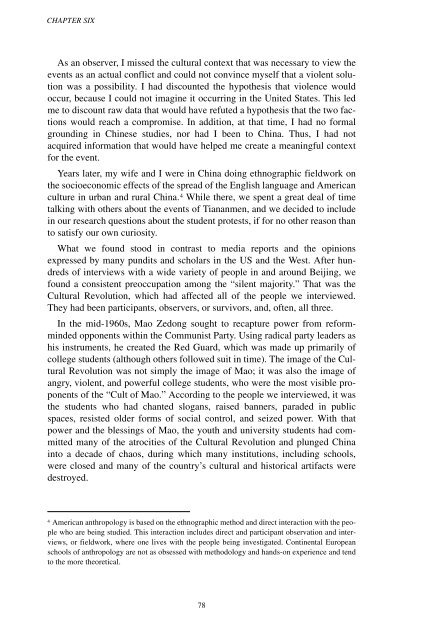Analytic Culture in the U.S. Intelligence Community (PDF) - CIA
Analytic Culture in the U.S. Intelligence Community (PDF) - CIA
Analytic Culture in the U.S. Intelligence Community (PDF) - CIA
Create successful ePaper yourself
Turn your PDF publications into a flip-book with our unique Google optimized e-Paper software.
CHAPTER SIX<br />
As an observer, I missed <strong>the</strong> cultural context that was necessary to view <strong>the</strong><br />
events as an actual conflict and could not conv<strong>in</strong>ce myself that a violent solution<br />
was a possibility. I had discounted <strong>the</strong> hypo<strong>the</strong>sis that violence would<br />
occur, because I could not imag<strong>in</strong>e it occurr<strong>in</strong>g <strong>in</strong> <strong>the</strong> United States. This led<br />
me to discount raw data that would have refuted a hypo<strong>the</strong>sis that <strong>the</strong> two factions<br />
would reach a compromise. In addition, at that time, I had no formal<br />
ground<strong>in</strong>g <strong>in</strong> Ch<strong>in</strong>ese studies, nor had I been to Ch<strong>in</strong>a. Thus, I had not<br />
acquired <strong>in</strong>formation that would have helped me create a mean<strong>in</strong>gful context<br />
for <strong>the</strong> event.<br />
Years later, my wife and I were <strong>in</strong> Ch<strong>in</strong>a do<strong>in</strong>g ethnographic fieldwork on<br />
<strong>the</strong> socioeconomic effects of <strong>the</strong> spread of <strong>the</strong> English language and American<br />
culture <strong>in</strong> urban and rural Ch<strong>in</strong>a. 4 While <strong>the</strong>re, we spent a great deal of time<br />
talk<strong>in</strong>g with o<strong>the</strong>rs about <strong>the</strong> events of Tiananmen, and we decided to <strong>in</strong>clude<br />
<strong>in</strong> our research questions about <strong>the</strong> student protests, if for no o<strong>the</strong>r reason than<br />
to satisfy our own curiosity.<br />
What we found stood <strong>in</strong> contrast to media reports and <strong>the</strong> op<strong>in</strong>ions<br />
expressed by many pundits and scholars <strong>in</strong> <strong>the</strong> US and <strong>the</strong> West. After hundreds<br />
of <strong>in</strong>terviews with a wide variety of people <strong>in</strong> and around Beij<strong>in</strong>g, we<br />
found a consistent preoccupation among <strong>the</strong> “silent majority.” That was <strong>the</strong><br />
Cultural Revolution, which had affected all of <strong>the</strong> people we <strong>in</strong>terviewed.<br />
They had been participants, observers, or survivors, and, often, all three.<br />
In <strong>the</strong> mid-1960s, Mao Zedong sought to recapture power from reformm<strong>in</strong>ded<br />
opponents with<strong>in</strong> <strong>the</strong> Communist Party. Us<strong>in</strong>g radical party leaders as<br />
his <strong>in</strong>struments, he created <strong>the</strong> Red Guard, which was made up primarily of<br />
college students (although o<strong>the</strong>rs followed suit <strong>in</strong> time). The image of <strong>the</strong> Cultural<br />
Revolution was not simply <strong>the</strong> image of Mao; it was also <strong>the</strong> image of<br />
angry, violent, and powerful college students, who were <strong>the</strong> most visible proponents<br />
of <strong>the</strong> “Cult of Mao.” Accord<strong>in</strong>g to <strong>the</strong> people we <strong>in</strong>terviewed, it was<br />
<strong>the</strong> students who had chanted slogans, raised banners, paraded <strong>in</strong> public<br />
spaces, resisted older forms of social control, and seized power. With that<br />
power and <strong>the</strong> bless<strong>in</strong>gs of Mao, <strong>the</strong> youth and university students had committed<br />
many of <strong>the</strong> atrocities of <strong>the</strong> Cultural Revolution and plunged Ch<strong>in</strong>a<br />
<strong>in</strong>to a decade of chaos, dur<strong>in</strong>g which many <strong>in</strong>stitutions, <strong>in</strong>clud<strong>in</strong>g schools,<br />
were closed and many of <strong>the</strong> country’s cultural and historical artifacts were<br />
destroyed.<br />
4<br />
American anthropology is based on <strong>the</strong> ethnographic method and direct <strong>in</strong>teraction with <strong>the</strong> people<br />
who are be<strong>in</strong>g studied. This <strong>in</strong>teraction <strong>in</strong>cludes direct and participant observation and <strong>in</strong>terviews,<br />
or fieldwork, where one lives with <strong>the</strong> people be<strong>in</strong>g <strong>in</strong>vestigated. Cont<strong>in</strong>ental European<br />
schools of anthropology are not as obsessed with methodology and hands-on experience and tend<br />
to <strong>the</strong> more <strong>the</strong>oretical.<br />
78
















